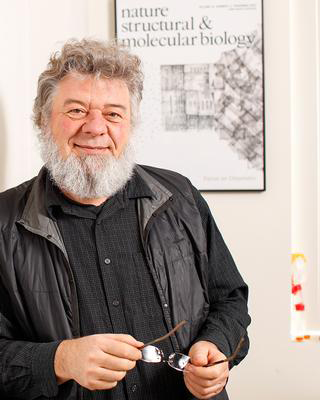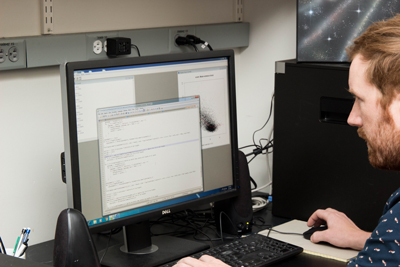About The Lab

Cooperation of oncogenic mutations in the control of malignancy:
- Understand the molecular basis for oncogene cooperation
- Identify unique features of gene networks in cancer cells vs. normal cells
- Exploit such features of cancer cells for targeted approaches towards therapeutic intervention
- Systems biology of cancer cells
Carcinogenesis is a process driven by multiple co-operating oncogenic mutations in which features of the cancer cell phenotype, such as proliferative advantage, only emerge as a result of the interplay between these mutations. This is consistent with the notion that many divergent cancers share a limited number of disease mechanisms with common underlying signaling networks, despite the many genes implicated in the disease.
The Land laboratory has pioneered investigation of the nature and underlying principles of cancer gene cooperation originating with the discovery that multiple oncogenic mutations are required for malignant cell transformation. Using a wide variety of experimental approaches, including genomics and systems biology, the laboratory has demonstrated that the cooperation of cancer-promoting genetic lesions is strongly reflected by synergistic modulation in signaling and the gene networks of malignant cells.
Recently, the laboratory has identified molecular events downstream of cooperating oncogenic mutations that are critical to cell transformation (McMurray et al., 2008). Using genomic approaches, approximately 100 genes that alter their expression synergistically in response to the combined effect of two oncogenic mutations were identified. Importantly, the regulation of these ‘cooperation response genes’ (CRG) is critical for the cancer phenotype at surprisingly high frequency, indicating that oncogenic mutations cooperate through synergistic regulation of downstream gene networks. CRGs control diverse cellular processes, such as cell signaling, survival, motility, invasiveness and self-renewal, thus indicating how cooperating oncogenic mutations ultimately affect multiple parallel cancer cell traits. Several research projects that focus on the nature of cancer cells as highly integrated systems are being pursued (see also below).
 We have shown that anti-cancer agents can be identified through their ability to reverse the CRG expression profile. Specifically, we find that exposure to histone deacetylase inhibitors (HDACi) induced an extensive reversal of the CRG expression signature, with concomitant abrogation of tumor-forming potential. Further, gene perturbation experiments show that the CRG response to HDI is essential for HDI anti-tumor activity. The CRG expression profile thus provides access to underlying mechanism of drug action in anti cancer drug discovery and can serve as a “cancer causality signature” These findings provide proof-of-concept for the use of the CRG signature as a novel means of drug discovery with relevance to underlying anti-cancer drug mechanisms (Sampson et al., 2013).
We have shown that anti-cancer agents can be identified through their ability to reverse the CRG expression profile. Specifically, we find that exposure to histone deacetylase inhibitors (HDACi) induced an extensive reversal of the CRG expression signature, with concomitant abrogation of tumor-forming potential. Further, gene perturbation experiments show that the CRG response to HDI is essential for HDI anti-tumor activity. The CRG expression profile thus provides access to underlying mechanism of drug action in anti cancer drug discovery and can serve as a “cancer causality signature” These findings provide proof-of-concept for the use of the CRG signature as a novel means of drug discovery with relevance to underlying anti-cancer drug mechanisms (Sampson et al., 2013).
We also have extended our work to malignant stem cells. These cells represent a biologically distinct subpopulation of myeloid leukemia cells, which display reduced cell cycle activity and increased resistance to therapeutic challenge. In order to better understand key biological properties and underlying regulatory mechanisms of leukemia stem cells (LSCs), we identified CRGs specific to LSCs. Using both a primary mouse model and human leukemia specimens, our findings show that CRGs are comprised of genes previously undescribed in leukemia pathogenesis that control multiple pathways modulating LSC biology. In addition, we demonstrate that the CRG expression profile can be used as a drug discovery tool to facilitate the identification of compounds that selectively target the LSC population. We conclude that CRG-based analyses provide a powerful means to characterize the basic biology of LSCs as well as to identify improved methods for therapeutic targeting (Ashton et al., 2012).
 The cholesterol exporter function of the ABCA1 gene, a down-regulated CRG, has tumor suppressor activity. The ABCA1 protein mediates the transfer of cellular cholesterol across the plasma membrane to apolipoprotein A-I. Loss-of-function mutations in the ABCA1 gene induce Tangier disease and familial hypoalphalipoproteinemia, both cardio-vascular conditions characterized by abnormally low levels of serum cholesterol, increased cholesterol in macrophages and subsequent formation of vascular plaque. Increased intra-cellular cholesterol levels are also frequently found in cancer cells. We have demonstrated anti-cancer activity of ABCA1 efflux function, which is compromised following inhibition of ABCA1 gene expression by oncogenic mutations or cancer-specific ABCA1 loss-of-function mutations. In concert with elevated cholesterol synthesis found in cancer cells, ABCA1 deficiency allows for increased mitochondrial cholesterol, inhibits release of mitochondrial cell death-promoting molecules and thus facilitates cancer cell survival, overall suggesting that elevated mitochondrial cholesterol is essential to the cancer phenotype (Smith and Land, 2012).
The cholesterol exporter function of the ABCA1 gene, a down-regulated CRG, has tumor suppressor activity. The ABCA1 protein mediates the transfer of cellular cholesterol across the plasma membrane to apolipoprotein A-I. Loss-of-function mutations in the ABCA1 gene induce Tangier disease and familial hypoalphalipoproteinemia, both cardio-vascular conditions characterized by abnormally low levels of serum cholesterol, increased cholesterol in macrophages and subsequent formation of vascular plaque. Increased intra-cellular cholesterol levels are also frequently found in cancer cells. We have demonstrated anti-cancer activity of ABCA1 efflux function, which is compromised following inhibition of ABCA1 gene expression by oncogenic mutations or cancer-specific ABCA1 loss-of-function mutations. In concert with elevated cholesterol synthesis found in cancer cells, ABCA1 deficiency allows for increased mitochondrial cholesterol, inhibits release of mitochondrial cell death-promoting molecules and thus facilitates cancer cell survival, overall suggesting that elevated mitochondrial cholesterol is essential to the cancer phenotype (Smith and Land, 2012).
Mutations in p53 and RAS potently cooperate in oncogenic transformation and correspondingly these genetic alterations frequently coexist in pancreatic ductal adenocarcinoma (PDA) and other human cancers. As described above, CRGs are downstream mediators of tumorigenesis. Recently we have shown that the synergistically activated gene Plac8 is critical for pancreatic cancer growth. Silencing of Plac8 in cell lines suppresses tumor formation by blocking autophagy, a process essential for maintaining metabolic homeostasis in PDA, and genetic inactivation in an engineered mouse model inhibits PDA progression. We show that Plac8 is a critical regulator of the autophagic machinery that localizes to the lysosomal compartment and facilitates lysosome-autophagosome fusion. Plac8 thus provides a mechanistic link between primary oncogenic mutations and the induction of autophagy, a central mechanism of metabolic reprogramming, during PDA progression. Autophagy is a multistep recycling process critical to growth and survival of advanced cancers including pancreatic cancer. Notably, Plac8 deficiency, though well tolerated by normal tissues, significantly impedes tumor growth, offering the disruption of autophagosome-lysosome fusion as a potential therapeutic window (Kinsey et al., 2014).